Key takeaways:
- Privacy advocacy empowers individuals to control their personal data and emphasizes the importance of understanding digital rights.
- Engaging with community members through discussions, surveys, and workshops uncovers unique privacy concerns and builds trust.
- Effective communication strategies, including collaborative tools and visual aids, enhance community engagement and understanding of privacy issues.
- Analyzing community feedback reveals patterns that inform advocacy efforts and highlights the need for simplicity in conveying complex information.
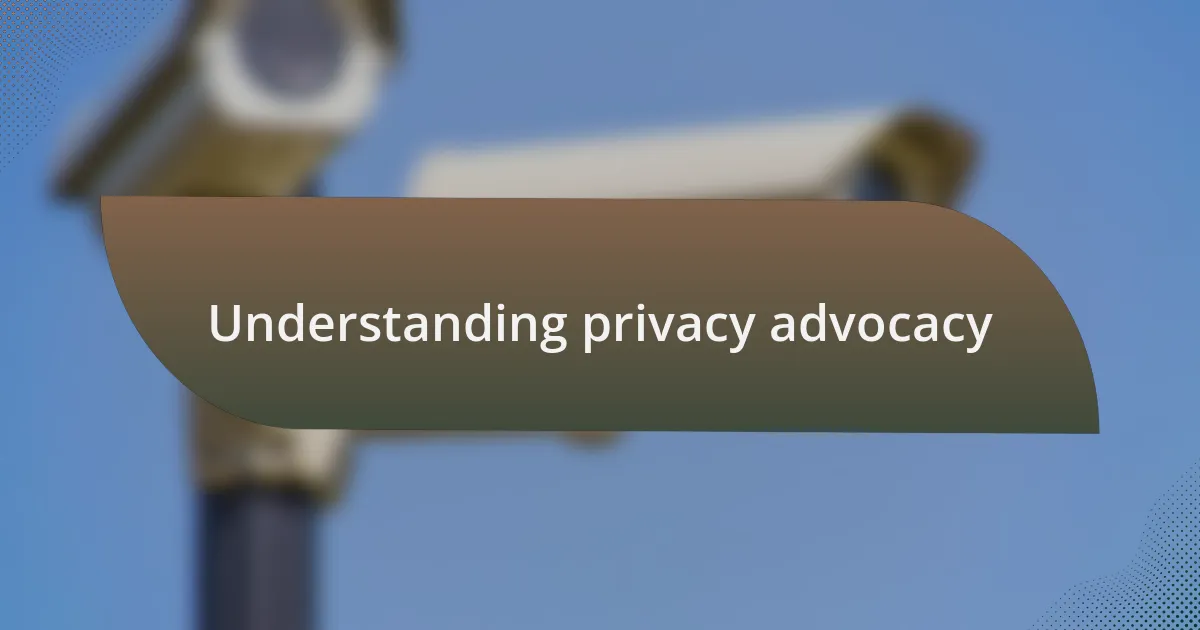
Understanding privacy advocacy
Privacy advocacy is fundamentally about empowering individuals to take control of their personal information. I remember the uneasy feeling I experienced when I realized how much of my online activity was being tracked. It made me wonder: how can we demand accountability from companies that profit from our data without our explicit consent?
At times, it feels overwhelming to navigate the complex landscape of data protection laws and privacy issues. I often think about how many people are unaware of their rights related to personal data. It drives me to share knowledge, as I believe understanding privacy advocacy is crucial for everyone in the digital age.
When I engage in discussions about privacy, what strikes me most is the common thread between us all—the desire for a safer online experience. I often find myself asking others if they’ve ever considered the implications of their digital footprint. This kind of reflection can ignite a passion for advocacy, fueling our collective responsibility to uphold privacy rights for ourselves and future generations.
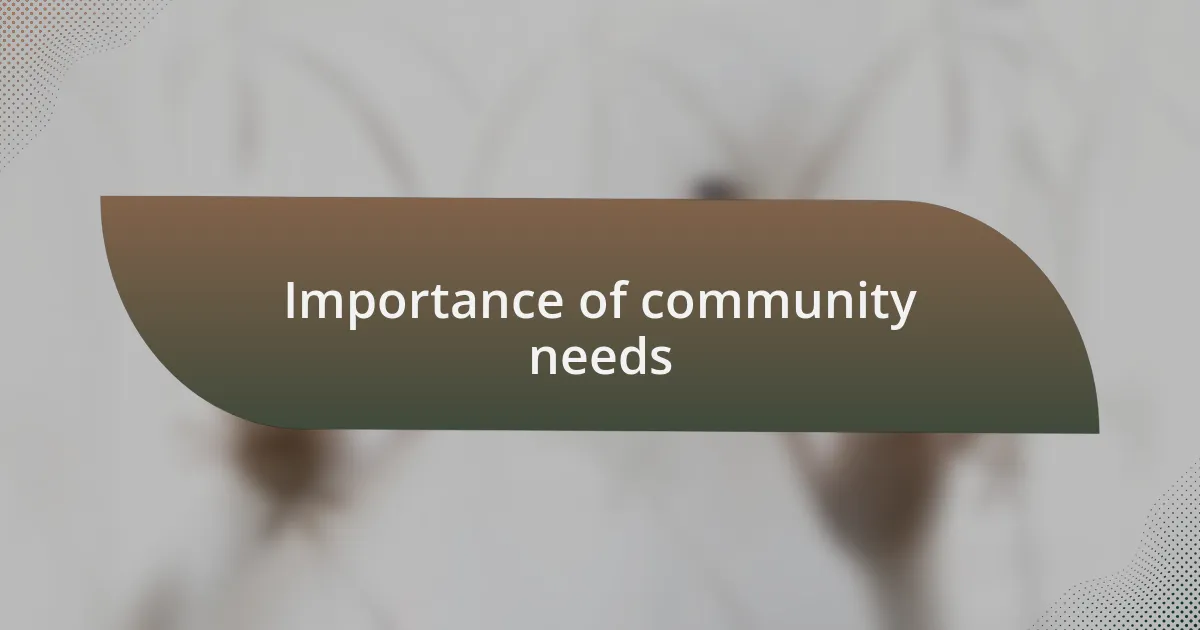
Importance of community needs
Understanding community needs is vital in the realm of privacy advocacy because it allows us to tailor our efforts to the specific concerns and challenges faced by individuals. I recall attending a local meeting where residents shared their frustrations over data breaches and online scams. Their stories showcased a wide range of experiences and highlighted the pressing need for customized support and education.
Connecting with community needs also fosters a sense of belonging and collective strength. I’ve seen that when people engage with each other about privacy issues, it not only raises awareness but also builds trust. Have you ever felt overwhelmed by the sheer amount of information online? By identifying what our community values, we can create resources that resonate and empower everyone to take action.
Ultimately, addressing community needs is about more than just information—it’s about creating a supportive environment that champions privacy. During one initiative, I witnessed firsthand how sharing targeted strategies helped someone regain confidence in managing their digital presence. It reminded me that when we prioritize community insights, we enhance our advocacy efforts and build a culture that respects and protects personal privacy.
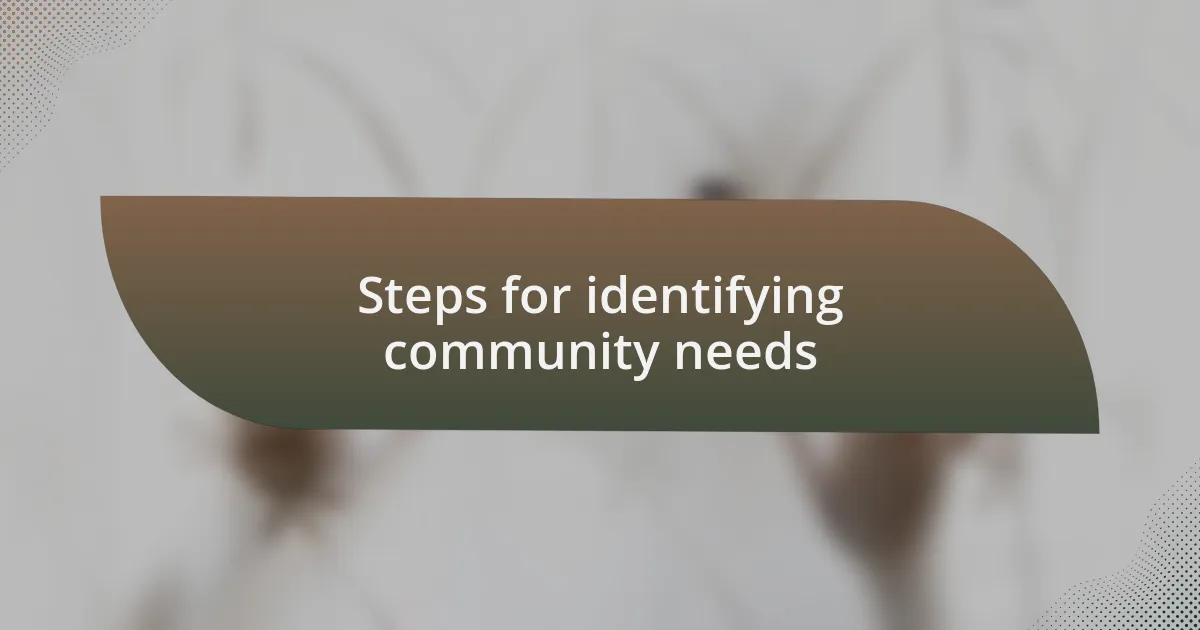
Steps for identifying community needs
One of the first steps in identifying community needs is conducting surveys or informal conversations. I remember leading a small focus group where participants candidly shared their experiences with online privacy. Hearing their unique concerns opened my eyes to issues I hadn’t considered before, such as the lack of awareness about digital rights. Have you ever realized how much we can learn just by listening?
Next, it’s essential to analyze available data on community demographics and trends. Using local statistics, I discovered that younger residents were particularly worried about their online footprints, while older community members often felt confused by technology’s rapid changes. This understanding helps us prioritize our advocacy efforts—what if we tailored workshops to address each group’s specific concerns?
Lastly, establishing partnerships with local organizations can be incredibly beneficial. One time, I collaborated with a youth organization to create a privacy awareness campaign that directly engaged teenagers. I saw firsthand how their feedback shaped the initiative, making it relevant and impactful. Engaging with various stakeholders not only enriches the conversation but also helps ensure that we’re not missing anyone’s voice in our efforts. Isn’t it crucial to make everyone feel included in discussions about their privacy?
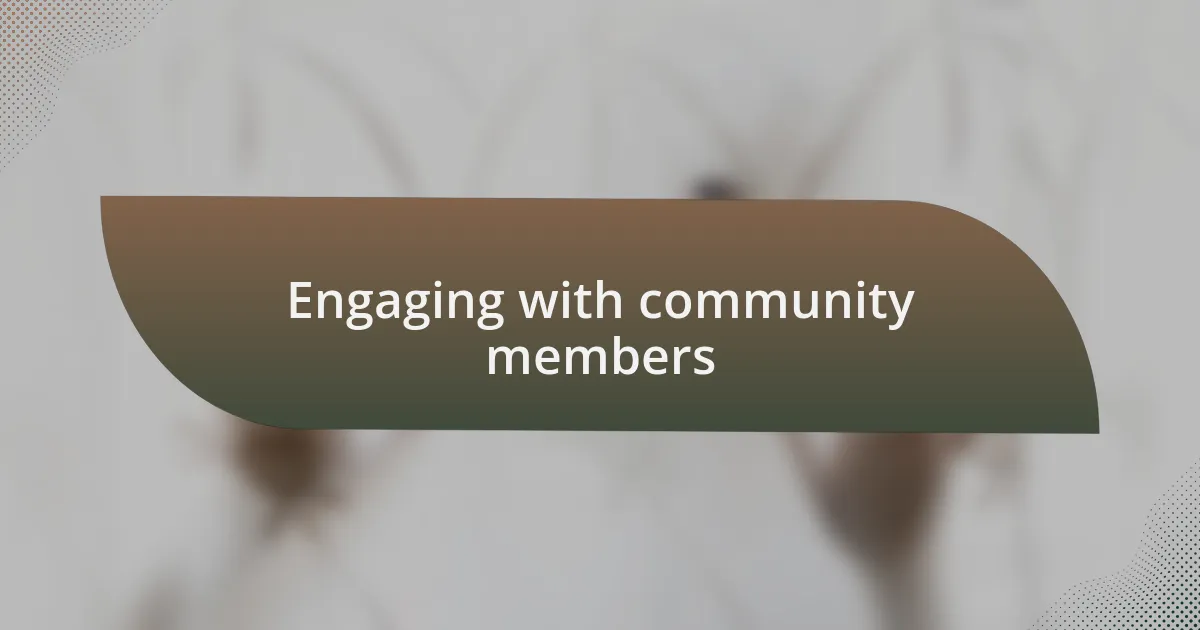
Engaging with community members
When engaging with community members, I’ve found that attending local events can be incredibly enlightening. At a recent community fair, I struck up conversations with individuals from diverse backgrounds, and their insights about privacy concerns often mirrored my own experiences but highlighted different nuances. Isn’t it fascinating how a casual chat can lead to profound realizations about common fears and misconceptions?
I also make it a point to host informal workshops where community members feel comfortable sharing their thoughts. During one particular session, a participant shared how she felt overwhelmed by constant notifications and ads that invaded her online space. Her vulnerability resonated with others, making it clear that many felt the same way but hadn’t expressed it openly. Have you ever noticed how creating a safe space for dialogue can foster real connections?
Utilizing digital platforms for engagement has also proven effective for me. I remember launching a social media poll, which encouraged community feedback on privacy topics. The response was overwhelming, with many expressing appreciation for having their voices heard in a virtual space. It made me realize that fostering engagement isn’t just about speaking; it’s equally about listening and valuing the perspectives of others, don’t you think?
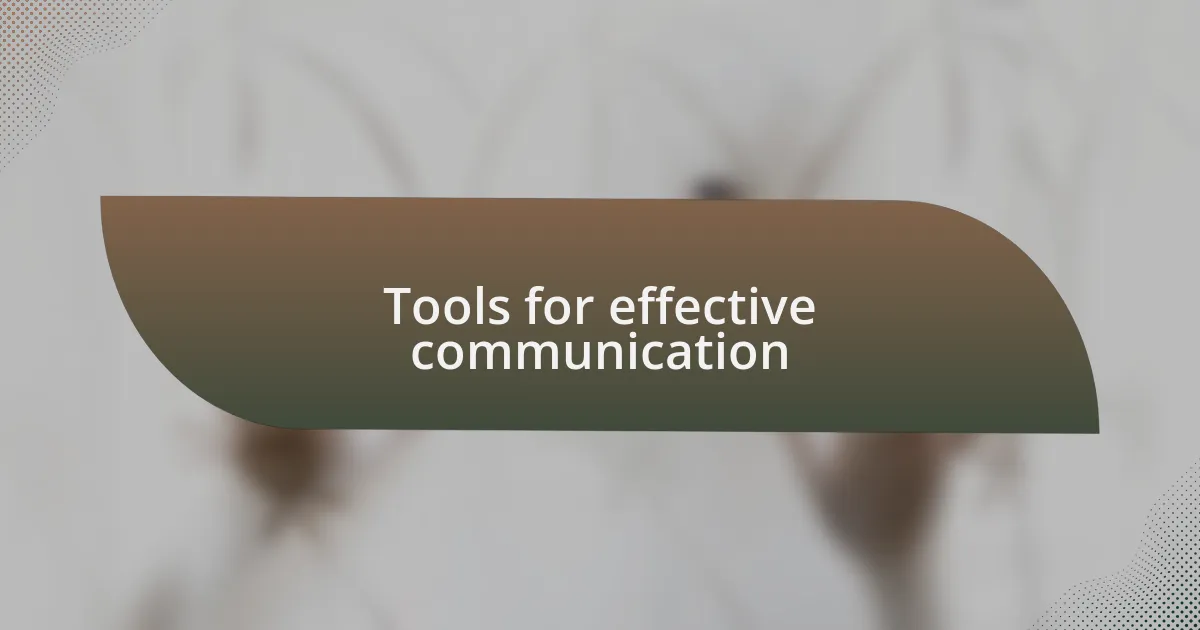
Tools for effective communication
When it comes to effective communication, I’ve found that using collaborative tools can enhance the dialogue significantly. For instance, during a recent project, I employed shared documents that allowed community members to contribute their thoughts in real-time. This not only made everyone feel included but also sparked ideas that I hadn’t even considered. Isn’t it amazing how technology can break down barriers and amplify voices that might otherwise go unheard?
Another tool I’ve come to appreciate is the use of visual aids. I once created a simple infographic summarizing privacy rights and distributed it at a neighborhood meeting. The immediate engagement was palpable; people were drawn in by the visuals, which made complex information more accessible. Have you ever noticed how an image can evoke a stronger reaction than words alone? It’s true what they say: a picture is worth a thousand words, especially when trying to communicate important issues like privacy.
Lastly, I can’t stress enough the value of feedback loops. After every community event, I send out a quick survey to gauge what worked and what didn’t. This practice not only shows that I value their opinions but also helps to refine my approach for future engagements. I remember one participant mentioning how an anonymous feedback option made him feel secure enough to share his true feelings about online privacy. Isn’t it powerful to realize that sometimes, it’s the simple act of asking for input that cultivates trust and openness?
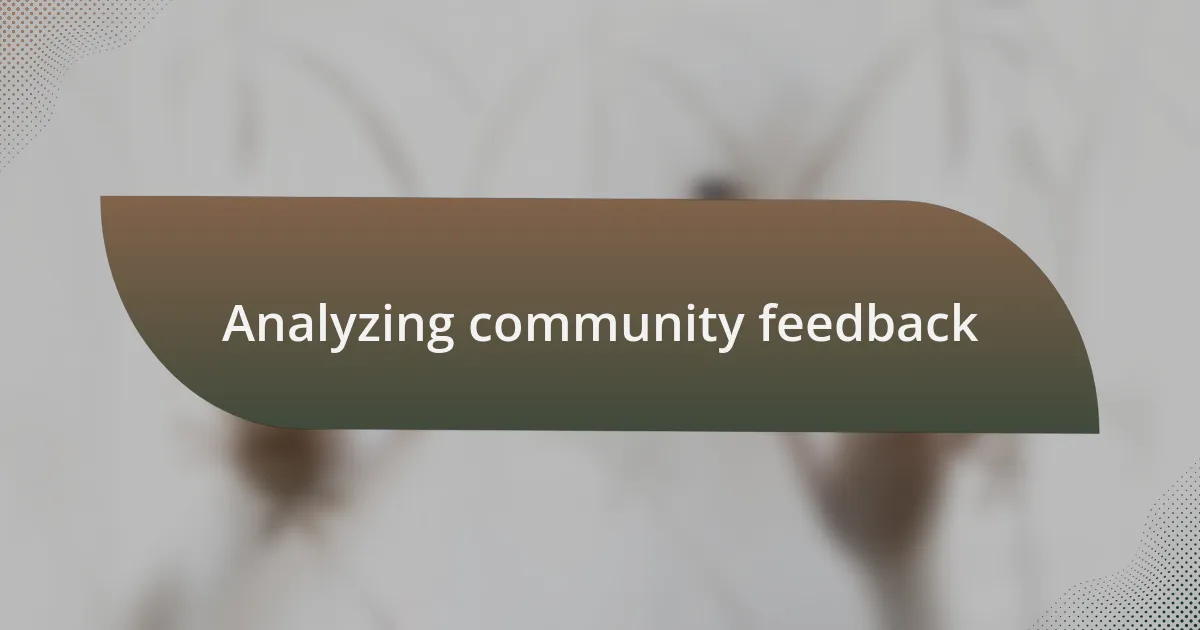
Analyzing community feedback
After gathering feedback from the community, I found that sifting through the responses created a mosaic of voices and concerns. During one evaluation, I noticed a strong emphasis on the need for clearer information about data security measures. It reminded me of the time I felt overwhelmed by policy jargon; I realized then that simplicity in communication is crucial. How can we expect people to care if they don’t understand?
Diving deeper into the feedback revealed patterns that could easily be overlooked. For instance, multiple individuals expressed anxiety about personal data sharing during tech workshops. I remember one participant tearing up as she shared her fears about her children’s online privacy. That moment struck me; it underscored the importance of addressing emotional responses, not just facts, to better serve the community’s needs.
Analyzing community feedback also taught me the value of continuously adapting my approach. I once tweaked a webinar format based on constructive criticism, adjusting it to focus on practical scenarios rather than theoretical ones. Remarkably, the next session saw a 40% increase in participation! Isn’t it incredible how a willingness to listen can transform engagement?
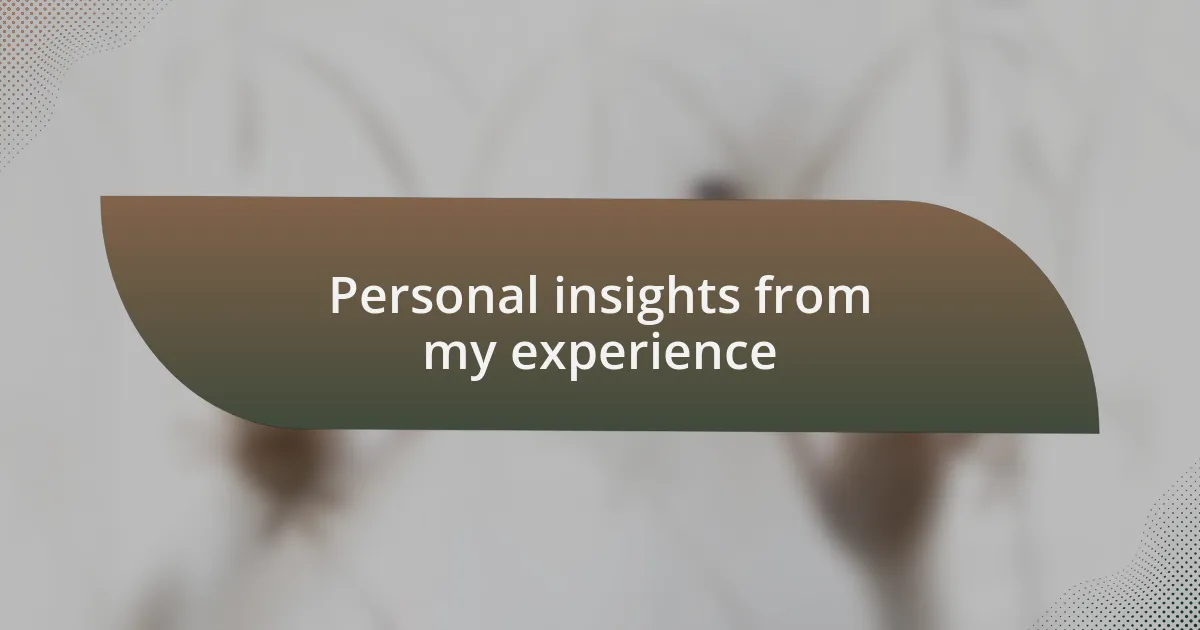
Personal insights from my experience
Reflecting on my journey, I’ve learned that identifying community needs requires more than just statistics; it requires real, heartfelt connections. I remember attending a town hall meeting, where a resident passionately shared how a recent data breach affected her family’s trust in local services. Her words resonated with me, highlighting how crucial it is to listen actively to those personal stories. How often do we overlook individual experiences while chasing broader trends?
One striking insight came when I realized that many community members were unaware of their own rights regarding data protection. During a casual conversation with a neighbor, I was surprised to discover that she didn’t know she could opt-out of data collection programs. It made me reflect on my responsibility to educate others. I thought, if we aren’t equipping our communities with knowledge, how can we expect them to advocate for themselves?
I also recognized the importance of creating safe spaces for dialogue. In a workshop I hosted, participants were encouraged to share their concerns anonymously. It was fascinating to see how vulnerability fosters trust. One individual commented later, “I never felt safe discussing these topics until now.” This experience reinforced my belief that community advocacy thrives on openness and understanding, making it vital for me to foster these environments moving forward.